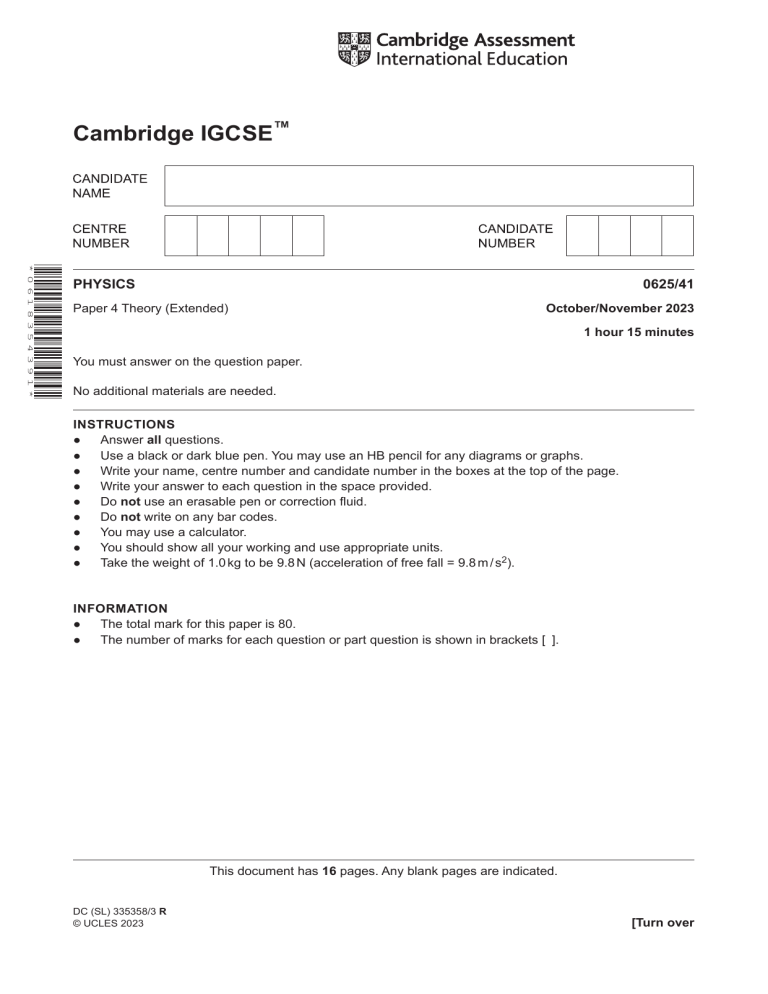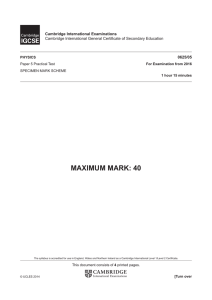
Cambridge IGCSE™
* 0 6 1 8 3 5 4 3 9 1 *
PHYSICS
0625/41
Paper 4 Theory (Extended)
October/November 2023
1 hour 15 minutes
You must answer on the question paper.
No additional materials are needed.
INSTRUCTIONS
●
Answer all questions.
●
Use a black or dark blue pen. You may use an HB pencil for any diagrams or graphs.
●
Write your name, centre number and candidate number in the boxes at the top of the page.
●
Write your answer to each question in the space provided.
●
Do not use an erasable pen or correction fluid.
●
Do not write on any bar codes.
●
You may use a calculator.
●
You should show all your working and use appropriate units.
●
Take the weight of 1.0 kg to be 9.8 N (acceleration of free fall = 9.8 m / s2).
INFORMATION
●
The total mark for this paper is 80.
●
The number of marks for each question or part question is shown in brackets [ ].
This document has 16 pages. Any blank pages are indicated.
DC (SL) 335358/3 R
© UCLES 2023
[Turn over
2
1
A girl holds a rubber ball out of a window of a tall building. The mass of the ball is 0.20 kg. The ball
is at rest 10 m above a concrete path.
(a) Calculate the gravitational potential energy of the ball relative to the concrete path.
gravitational potential energy = ......................................................... [2]
(b) The girl releases the ball and it falls towards the path. The ball strikes the path and bounces
vertically upwards.
Fig. 1.1 shows the ball falling towards the path.
ball
10 m
concrete path
Fig. 1.1
The speed of the ball immediately before it strikes the path is 14 m / s.
The speed of the ball immediately after it strikes the path is 12 m / s.
(i)
Calculate the kinetic energy of the ball immediately after it strikes the concrete path.
kinetic energy = ......................................................... [2]
(ii)
Show that the change in momentum of the ball when it bounces off the path is 5.2 kg m / s.
[3]
© UCLES 2023
0625/41/O/N/23
3
(iii)
The ball is in contact with the path for 0.25 s.
Calculate the average resultant force on the ball when it is in contact with the path.
force = ......................................................... [2]
[Total: 9]
© UCLES 2023
0625/41/O/N/23
[Turn over
4
2
A copper cooking pan contains water. Fig. 2.1 shows the pan on a hotplate of a cooker.
Fig. 2.1
Copper is a metal.
(a) Thermal energy is conducted through all solids by lattice vibrations.
Describe one other way in which thermal energy is conducted through the copper.
...................................................................................................................................................
...................................................................................................................................................
...................................................................................................................................................
............................................................................................................................................. [3]
(b) The outside surface of the cooking pan is kept clean by regular polishing.
Explain one other advantage of keeping the surface of the pan shiny.
...................................................................................................................................................
...................................................................................................................................................
............................................................................................................................................. [2]
(c) The thermal energy passes into the water through the base of the pan.
Identify the main method by which thermal energy is transferred throughout the water.
............................................................................................................................................. [1]
[Total: 6]
© UCLES 2023
0625/41/O/N/23
5
3
Liquids are difficult to compress whereas gases can be compressed easily.
(a) Explain, in terms of particles, why it is difficult to compress liquids.
...................................................................................................................................................
...................................................................................................................................................
............................................................................................................................................. [2]
(b) Fig. 3.1 shows a rectangular block floating in water. The density of the water is 1000 kg / m3.
rectangular block
atmosphere
water
0.087 m
base
Fig. 3.1
The area of the base of the block is 0.014 m2. The base of the block is at a depth of 0.087 m
below the surface of the water.
(i)
Show that the pressure due to the water at the base of the block is approximately 850 Pa.
[2]
(ii)
Calculate the force F on the base of the block caused by the pressure given in (b)(i).
F = ......................................................... [2]
(iii)
Force F is equal to the weight of the block.
Calculate the mass of the block.
mass = ......................................................... [2]
[Total: 8]
© UCLES 2023
0625/41/O/N/23
[Turn over
6
4
A radio transmitter is a very tall, thin cylinder. It is prevented from falling over by wires which have
one end fixed to the transmitter and the other end fixed in the ground. The ends of the wires in the
ground are a long distance from the transmitter.
Fig. 4.1 shows the transmitter and two of the wires.
transmitter
G
wire W
ground
base
Fig. 4.1
(a) The centre of gravity G is shown on Fig. 4.1.
(i)
State what is meant by centre of gravity.
...........................................................................................................................................
..................................................................................................................................... [1]
(ii)
Explain why the radio transmitter without the wires is a very unstable structure.
...........................................................................................................................................
..................................................................................................................................... [1]
(b) Wire W is under tension and it exerts a force T on the transmitter.
(i)
On Fig. 4.1, mark an arrow to show the force T exerted by wire W on the transmitter. [1]
(ii)
The force T produces a moment on the transmitter about its base.
Describe how the moment produced by T is calculated and indicate on Fig. 4.1 what is
meant by any other terms in the description.
...........................................................................................................................................
..................................................................................................................................... [3]
© UCLES 2023
0625/41/O/N/23
7
(c) The radio transmitter uses radio waves to transmit radio and television programmes.
State one other use of radio waves.
...................................................................................................................................................
............................................................................................................................................. [1]
[Total: 7]
© UCLES 2023
0625/41/O/N/23
[Turn over
8
5
Many methods of generating electrical power involve the use of water.
(a) Describe one method of generating electrical power from energy stored in water.
...................................................................................................................................................
...................................................................................................................................................
...................................................................................................................................................
...................................................................................................................................................
............................................................................................................................................. [3]
(b) For the method you chose in (a), state one advantage and one disadvantage of generating
electricity this way.
advantage .................................................................................................................................
...................................................................................................................................................
disadvantage ............................................................................................................................
...................................................................................................................................................
[2]
(c) State two methods of generating electrical power for which the main source of energy is not
the Sun.
1 ................................................................................................................................................
2 ................................................................................................................................................
[2]
[Total: 7]
© UCLES 2023
0625/41/O/N/23
9
6
A page of printed text is placed 18 cm from a converging lens of focal length 35 cm.
Fig. 6.1 is a scale diagram of the arrangement with each of the two principal focuses (focal points)
of the lens labelled F.
5.0 cm
5.0 cm
F
F
18 cm
page of printed text
lens
Fig. 6.1
(a) A length of 1.0 cm on the scale diagram represents an actual length of 5.0 cm.
(i)
By drawing on Fig. 6.1, locate the image of the page produced by the lens and label it I. [3]
(ii)
Using Fig. 6.1, determine the actual distance of image I from the lens.
actual distance from lens = ......................................................... [2]
(b) Converging lenses can be used as magnifying glasses.
State whether the image produced when a lens is used as a magnifying glass is real or
virtual. Explain why.
...................................................................................................................................................
............................................................................................................................................. [1]
(c) Suggest how someone who is long-sighted may benefit from using a converging lens.
...................................................................................................................................................
...................................................................................................................................................
............................................................................................................................................. [2]
[Total: 8]
© UCLES 2023
0625/41/O/N/23
[Turn over
10
7
(a) A plastic rod is uncharged.
When the rod is rubbed with a woollen cloth, the rod becomes negatively charged.
Explain, in terms of particles, why the rod becomes negatively charged.
...................................................................................................................................................
...................................................................................................................................................
............................................................................................................................................. [2]
(b) Fig. 7.1 shows a negatively charged metal sphere S.
–
–
–
–
–
sphere S
Fig. 7.1
There is an electric field surrounding S.
(i)
State what is meant by an electric field.
...........................................................................................................................................
..................................................................................................................................... [1]
(ii)
On Fig. 7.1, draw the pattern of the electric field surrounding sphere S and indicate its
direction.
[2]
(c) Fig. 7.2 shows a small negative charge Z placed near to sphere S.
–
–
–
–
–
Z
sphere S
Fig. 7.2
Charge Z experiences a force due to the electric field surrounding S.
On Fig. 7.2, draw an arrow to show the direction of this force on Z.
[1]
[Total: 6]
© UCLES 2023
0625/41/O/N/23
11
BLANK PAGE
© UCLES 2023
0625/41/O/N/23
[Turn over
12
8
A cylinder is made of modelling clay. The modelling clay is an electrical conductor.
Fig. 8.1 shows the cylinder.
cross-sectional area
length
Fig. 8.1
The cylinder is connected into a circuit.
Fig. 8.2 shows that the circuit also includes a battery of electromotive force (e.m.f.) 9.0 V and a
resistor P.
9.0 V
P
cylinder of modelling clay
Fig. 8.2
The resistance of P is 4.0 Ω. The current in P is 1.5 A.
(a) Calculate:
(i)
the magnitude X of the charge that flows through P in 600 s
X = ......................................................... [2]
(ii) the resistance of the cylinder of modelling clay.
resistance = ......................................................... [3]
© UCLES 2023
0625/41/O/N/23
13
(b) The cylinder is removed from the circuit and replaced with a new cylinder made of the same
modelling clay.
The new cylinder is twice the length and has half the cross-sectional area of the first cylinder.
Calculate the time that it now takes for a charge of magnitude X to flow through resistor P.
time = ......................................................... [4]
[Total: 9]
© UCLES 2023
0625/41/O/N/23
[Turn over
14
9
Many household smoke alarms contain a sample of the radioactive isotope americium-241 (Am).
(a) Americium-241 is the isotope of the element americium that has the nucleon number (mass
number) 241.
(i)
State how the composition of a nucleus of americium-241 differs from that of a nucleus
of americium-242.
...........................................................................................................................................
..................................................................................................................................... [1]
(ii)
An atom of a different element has a nucleon number of 241.
State two differences between the composition of a nucleus of this atom and a nucleus
of americium-241.
1 ........................................................................................................................................
2 ........................................................................................................................................
[2]
(b) Americium-241 decays to an isotope of neptunium (Np) by alpha-particle (α-particle) emission.
(i)
Complete the equation for this decay.
241
Am
.....
(ii)
.....
Np
93
+
.....
α
.....
[3]
One reason for using an isotope that emits α-particles in a smoke detector is that
α-particles are more strongly ionising than beta-particles (β-particles).
Explain why α-particles are more strongly ionising than β-particles.
...........................................................................................................................................
...........................................................................................................................................
..................................................................................................................................... [2]
(iii)
The isotope of neptunium produced by americium-241 is also radioactive.
The decay of this isotope of neptunium produces an isotope of protactinium which
decays by β-emission. β-particles are more penetrating than α-particles.
The half-life of neptunium is longer than two million years.
Using this information, explain the advantage of this long half-life for the use and safe
disposal of a household smoke alarm.
...........................................................................................................................................
...........................................................................................................................................
..................................................................................................................................... [2]
[Total: 10]
© UCLES 2023
0625/41/O/N/23
15
10 The Milky Way is one of many billions of galaxies. Each galaxy contains many billions of stable stars.
(a) Stable stars transfer energy into space by emitting electromagnetic radiation from their
surfaces.
Describe what happens in the core of a stable star to release energy that is eventually
transferred into space.
...................................................................................................................................................
...................................................................................................................................................
...................................................................................................................................................
............................................................................................................................................. [3]
(b) On the Earth, light from a distant galaxy is observed and analysed by astronomers. This
information is used to determine the speed at which the galaxy is moving away from the
Earth.
(i)
Describe how the observed light is different from when it was emitted.
...........................................................................................................................................
...........................................................................................................................................
..................................................................................................................................... [2]
(ii)
State the quantity that astronomers use to determine the speed at which the galaxy is
moving away.
..................................................................................................................................... [1]
(c) The Hubble constant H0 is equal to 2.2 × 10–18 per second.
(i)
Calculate the distance from the Earth of a galaxy that is moving away at a speed of
1.3 × 107 m / s.
distance = ......................................................... [2]
(ii)
Calculate an estimate for the age of the Universe. Give your answer in years.
age of the Universe = ............................................... years [2]
[Total: 10]
© UCLES 2023
0625/41/O/N/23
16
BLANK PAGE
Permission to reproduce items where third-party owned material protected by copyright is included has been sought and cleared where possible. Every
reasonable effort has been made by the publisher (UCLES) to trace copyright holders, but if any items requiring clearance have unwittingly been included, the
publisher will be pleased to make amends at the earliest possible opportunity.
To avoid the issue of disclosure of answer-related information to candidates, all copyright acknowledgements are reproduced online in the Cambridge
Assessment International Education Copyright Acknowledgements Booklet. This is produced for each series of examinations and is freely available to download
at www.cambridgeinternational.org after the live examination series.
Cambridge Assessment International Education is part of Cambridge Assessment. Cambridge Assessment is the brand name of the University of Cambridge
Local Examinations Syndicate (UCLES), which is a department of the University of Cambridge.
© UCLES 2023
0625/41/O/N/23







